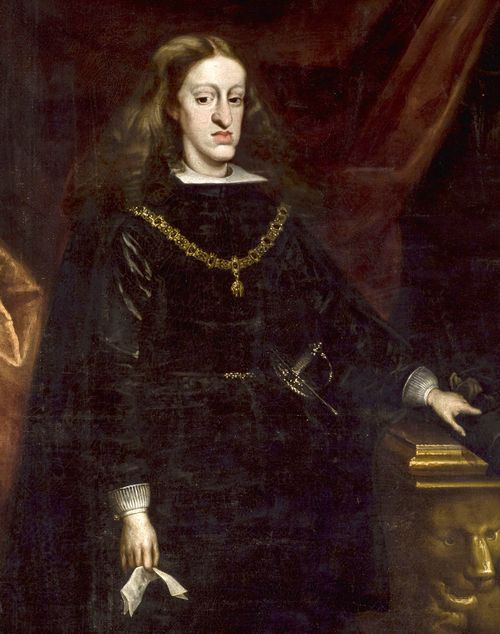Charles II
by Alberto Pradeau

Charles II was four years old when at the death of his father, Philip IV, he ascended the throne of Spain. As by the terms of the will of the deceased king, his successor was not to be permitted to govern until he had attained the age of fourteen, the Queen mother became the regent. Toward the end of 1675 Charles assumed full charge of the government, and in the following year, when only 15 years old, married Maria Louise of Orleans, granddaughter of Louis XIII of France. She died in 1639, and shortly after, Charles married Maria Anna, sister of Emperor Leopold of Austria. Charles II died on 1 November 1700, without issue.
An important event in the coinage of New Spain occurred during Charles' reign, when permission was granted to coin gold in the Mexico City mint. For the twenty four year period from 1665 to 1689, it is estimated there was an average yearly coinage in silver of $4.000,000—a total of $96,000,000. Beginning with 1690 record of the amounts coined was kept accurately.
| Year | Gold | Silver | Total |
| 1665 | 96.000,000.00 | 96.627,214.00 | |
| 1679 | 8,568.00 | ||
| 1680 | 130,382.00 | ||
| 1681 | 88,264.00 | ||
| 1682 | 50,000.00 | ||
| 1683 | 50,000.00 | ||
| 1684 | 50,000.00 | ||
| 1685 | 50,000.00 | ||
| 1686 | 50,000.00 | ||
| 1687 | 50,000.00 | ||
| 1688 | 50,000.00 | ||
| 1689 | 50,000.00 | ||
| 1690 | 50,000.00 | 5.285,581.00 | 5.335,581.00 |
| 1691 | 50,000.00 | 6.213,709.61 | 6.263,709.61 |
| 1692 | 50,000.00 | 5.352,729.31 | 5.402,729.31 |
| 1693 | 50,000.00 | 2.802,378.55 | 2.852,378.55 |
| 1694 | 214,610.00 | 5.840,529.56 | 6.055,139.56 |
| 1695 | 299,200.00 | 4.001,293.42 | 4.300,493.42 |
| 1696 | 200,000.00 | 3.190,618.09 | 3.390,618.09 |
| 1697 | 200,000.00 | 4.459,947.60 | 4.659,947.60 |
| 1698 | 200,000.00 | 3.319,765.84 | 3.519,765.84 |
| 1699 | 200,000.00 | 3.504,787.06 | 3.704,787.06 |
| 1700 | 200,000.00 | 3.379,122.15 | 3.579,122.15 |
| 2.341,024.00 | 143.350,462.19 | 145.691,486.19 |
Gold Coinage
The queen, in the name of Charles II, issued a cedula on 25 February 1675, authorizing the coinage of gold in New Spain. On 23 May of the same year this privilege was publicly proclaimed in the City of Mexico and was received with much rejoicing. Bands played in different parts of the city, the officers of the state issued forth on horseback, and marched in procession under arches of flowers that spanned the crowded streets. No gold, however, was coined until 23 December 1679, on which day the Viceroy and the members of the Audiencia (Court of Judicature) visited the mint to witness the coinage of the first pieces.
By order of 20 May 1676, issued by the Viceroy Fray Payo Henriquez de Rivera, the fineness for gold coins was set at twenty-two karats, and from a mark of pure gold it was ordered that sixty-eight escudosThe escudo is a monetary unit equal to one-eighth of a doubloon. A doubloon was worth sixteen pesos, therefore each escudo was worth two pesos. be coined. The senoreaje or king's duty for each mark of gold coined, was to be two pesos. For brassage, three and-a-half tominesThe tomin is a unit of weight representing twelve grains. of gold were to be chargedElhuyar, lndagaciones, etc. Madrid, 1818, p. 3..
The two pesos charged for seigniorage were equivalent to 9.75 tomines; if to this amount we add the three and a half tomines collected as brassage for each mark of gold coined, we obtain 13.25 tomines as the total charge. As each tomin of gold was worth a fraction under twenty-one cents, the 13.25 tomins equal $2.73 of our money.
According to Elhuyarpage 13 of the Indagaciones the following amounts were coined in gold:
During 1679— 63 marks, equal to 4,284 escudos or $ 8,568.00
During 1680—962 marks, equal to 65,416 escudos or 130,832.00
During 1681—649 marks, equal to 44,132 escudos or 88,264.00
These figures vary slightly from those given by Orozco y Berra, Bancroft, Medina, and the official records of the Mexican government.
The gold minted in New Spain was in denominations of eight, four, two and one escudos. The half-escudos seem not to have been minted prior to 1814, and diligent search has not revealed any of these tiny pieces from the Mexico City mint before that date.
A Spanish ounce contains 28.6875 grams or 442.7055 grains. The old Spanish-American gold piece of eight-escudos was also called onza (ounce) and-doubloon. It seldom, if ever, weighed a full ounce. When in very fine condition it generally weighs twenty-seven grams. Its subdivisions, the four, the two and the one escudos, are almost always short in weight, and the smaller the denomination the more pronounced is the shortage.
Silver Coinage
During the reign of Charles II, the Mexico City mint struck very few eight reales. Silver coins are found in both the round and the cob form. The latter predominate, are most irregular, and come in a multitude of odd shapes. The dies are almost identical with those of Philip IV, and unless there are identifying marks such as name, date or initial, it is probable that those having the most grotesque shapes are of Charles' reign.
The half-reales follow the same pattern as the previous half-reales, but are easily distinguished by the monogram CAROLVS. Within the C is a small figure 8 or a letter S.
